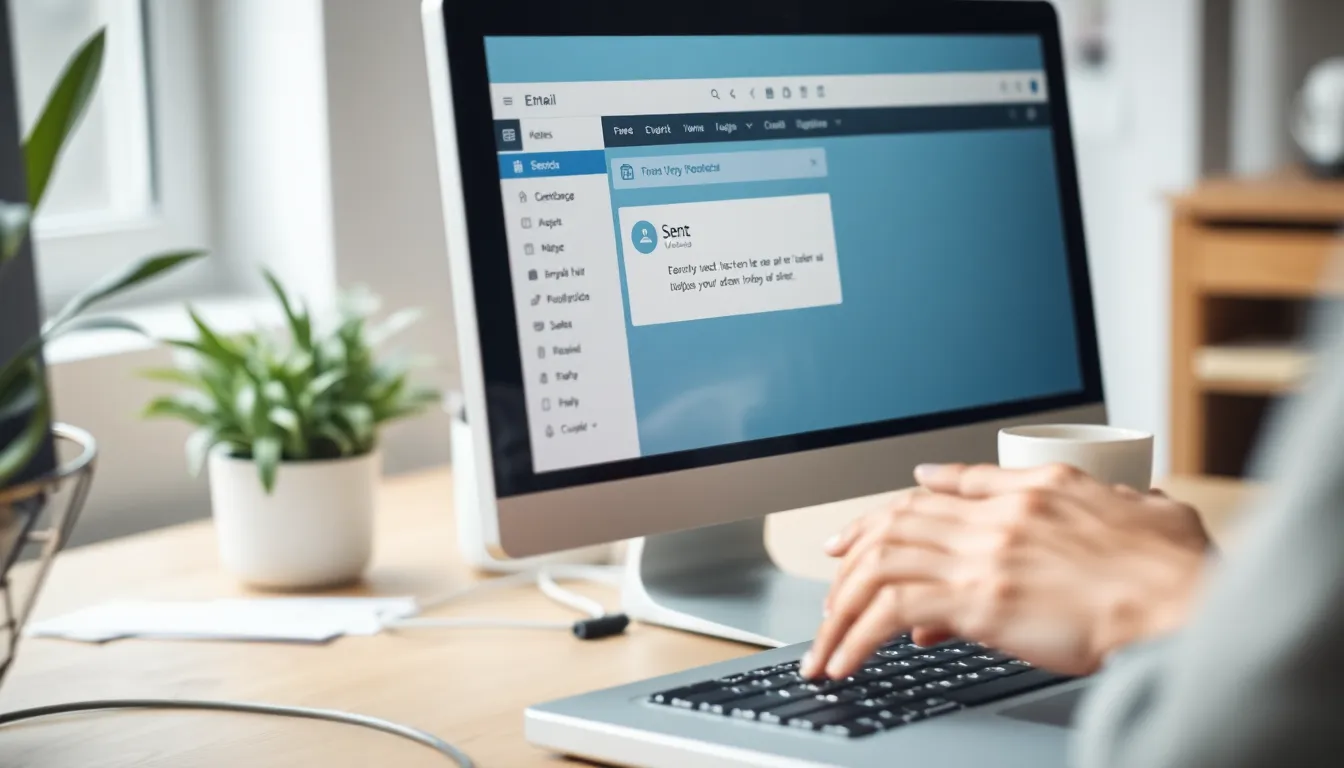We’ve all been there—hitting “send” only to realize seconds later that we’ve made a colossal mistake. Whether it’s a typo that could rival a toddler’s spelling or an accidental email to the wrong person, the panic sets in. Can you delete a sent email? The answer might surprise you, and it’s not as straightforward as you’d hope.
Table of Contents
ToggleCan You Delete a Sent Email?
Deleting a sent email isn’t as straightforward as it seems. Once an email is sent, the action usually leads to its permanent delivery to the recipient’s inbox. Certain email platforms offer a feature called “Undo Send,” which allows users to retract an email shortly after sending it. For example, Gmail offers this feature for up to 30 seconds.
Retracting an email doesn’t guarantee the recipient hasn’t seen it. Even with such features, if users miss the time window, the email remains accessible to the recipient. Some email providers implement server-side recall functions. Microsoft Outlook, for instance, allows users to recall messages, but this only works if both sender and recipient use Outlook within the same organization.
Users may try sending a follow-up email to address any errors. Sending a clarification or an apology can manage misunderstandings effectively. In professional settings, such strategies are often recommended following an undesired send.
Be aware of privacy and security settings that might affect email recall options. Many email clients don’t support this functionality fully, hindering users’ ability to delete sent messages. Once an email enters someone’s inbox, retrieving it can become increasingly complicated.
Always consider double-checking recipients and content before hitting send. Implementing an email delay feature can provide an additional safety net. It allows users extra time to reconsider their sending choices while preventing premature delivery. Understanding the limitations of deleting sent emails helps users navigate email communications more effectively.
Understanding Email Protocols

Email protocols govern how messages are sent and received, and they play a crucial role in determining the ability to delete a sent email. Upon sending an email, it travels through specified protocols like SMTP (Simple Mail Transfer Protocol), ensuring the swift transfer of the message to the recipient’s server.
How Email Sending Works
Emails transmit via SMTP when sent. The sender’s email client encodes the message into a format suitable for delivery. Upon reaching the recipient’s mail server, the email is stored until retrieved by the recipient. Once the email arrives in the inbox, it becomes challenging to intervene. Many users might realize moments after sending that an error occurred, but the structured flow of email sending limits their ability to erase mistakes.
The Role of Email Servers
Email servers play pivotal roles in message delivery. They facilitate communication between different email accounts and handle incoming and outgoing emails. Each server retains copies of emails until they reach their destinations. Deleting a sent email isn’t feasible once it’s on the recipient’s server. For systems like Microsoft Outlook, server-side recall functions exist, but they depend on specific conditions, such as both sender and recipient being within the same organization. Understanding server functionalities helps users grasp their email’s journey and the implications of sending unwanted messages.
Options for Deleting Sent Emails
Deleting sent emails can depend on various factors, including the email provider and settings. Below are methods that can help manage sent emails.
Retracting Emails
Retracting an email is possible through specific features provided by some email services. Google offers an “Undo Send” option, which allows users to cancel an email within a short window after sending it. This feature only works if the user acts quickly, often within a few seconds. Microsoft Outlook users can take advantage of the server-side recall feature; however, this function only works when both sender and recipient are in the same organization. Recall attempts remain unsuccessful if the recipient has already opened the email. Understanding the limitations of these features is crucial for effectively managing sent emails.
Using Email Clients
Email clients can assist in handling sent messages with additional functionalities. Programs like Thunderbird or Outlook often include preferences to delay sending emails, giving users extra time to reconsider. This option creates a buffer period; if a reconsideration occurs, users can retract the email before it’s dispatched. Certain email clients also provide built-in recall features. Exploring these functionalities within individual preferences can improve email management significantly. Options vary, so users must check specific settings to take advantage of these capabilities effectively.
Limitations and Considerations
Deleting a sent email presents significant challenges. Various factors influence the success of retracting an email after it’s sent.
Timing Factors
Timing plays a critical role in email recall. Services like Gmail provide a brief window, typically five to 30 seconds, to use the “Undo Send” feature. Once this window closes, the email reaches the recipient’s inbox, making retraction impossible. Users relying on Microsoft Outlook’s recall feature must act quickly, as its effectiveness diminishes once the email is opened. Knowledge of timing requirements remains essential for managing emails effectively.
Recipient Actions
Recipient actions can impact the chances of successful email deletion. If a recipient opens the email, recalling it becomes futile. Further, email clients allow users to save messages even before they’re fully downloaded. Notifications may alert recipients, leading to the content being read even if the original email is deleted. Awareness of these dynamics enhances understanding of email communications, making it crucial for users to think ahead before sending messages.
Deleting a sent email is often more complicated than it seems. While features like “Undo Send” can provide a brief opportunity to retract a message it doesn’t guarantee that the recipient hasn’t seen it. Understanding the limitations of email protocols and server functionalities is essential for anyone navigating email communications.
For those who frequently find themselves regretting sent emails implementing an email delay feature can offer a helpful buffer. This allows for a moment of reconsideration before messages reach their intended recipients. Ultimately being mindful of the potential consequences of sending emails can help users communicate more effectively and avoid unnecessary mishaps.




